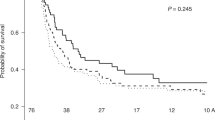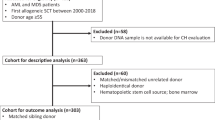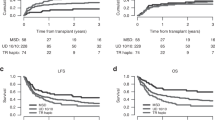Abstract
Recent studies suggest improved survival in patients with severe aplastic anemia receiving hematopoietic cell transplant (HCT) from unrelated donors with longer telomeres. Here, we tested whether this effect is generalizable to patients with acute leukemia. From the Center for International Blood and Marrow Transplant Research (CIBMTR®) database, we identified 1097 patients who received 8/8 HLA-matched unrelated HCT for acute myeloid leukemia (AML) or acute lymphocytic leukemia (ALL) between 2004 and 2012 with myeloablative conditioning, and had pre-HCT blood sample from the donor in CIBMTR repository. The median age at HCT for recipients was 40 years (range ≤1–68), and 32 years for donors (range = 18–61). We used qPCR for relative telomere length (RTL) measurement, and Cox proportional hazard models for statistical analyses. In a discovery cohort of 300 patients, longer donor RTL (>25th percentile) was associated with reduced risks of relapse (HR = 0.62, p = 0.05) and acute graft-versus-host disease II–IV (HR = 0.68, p = 0.05), and possibly with a higher probability of neutrophil engraftment (HR = 1.3, p = 0.06). However, these results did not replicate in two validation cohorts of 297 and 488 recipients. There was one exception; a higher probability of neutrophil engraftment was observed in one validation cohort (HR = 1.24, p = 0.05). In a combined analysis of the three cohorts, no statistically significant associations (all p > 0.1) were found between donor RTL and any outcomes.
This is a preview of subscription content, access via your institution
Access options
Subscribe to this journal
Receive 12 print issues and online access
$259.00 per year
only $21.58 per issue
Buy this article
- Purchase on Springer Link
- Instant access to full article PDF
Prices may be subject to local taxes which are calculated during checkout

Similar content being viewed by others
References
Horowitz MM, Gale RP, Sondel PM, Goldman JM, Kersey J, Kolb HJ, et al. Graft-versus-leukemia reactions after bone marrow transplantation. Blood 1990;75:555–62.
Kolb HJ. Graft-versus-leukemia effects of transplantation and donor lymphocytes. Blood 2008;112:4371–83. https://doi.org/10.1182/blood-2008-03-077974.
Pasquini M, Zhu X. Current uses and outcomes of hematopoietic stem cell transplantation: CIBMTR summary slides; 2015.
Baerlocher GM, Lansdorp PM. Telomere length measurements using fluorescence in situ hybridization and flow cytometry. Methods Cell Biol 2004;75:719–50.
Peters C, Schrappe M, von Stackelberg A, Schrauder A, Bader P, Ebell W, et al. Stem-cell transplantation in children with acute lymphoblastic leukemia: a prospective international multicenter trial comparing sibling donors with matched unrelated donors—the ALL-SCT-BFM-2003 trial. J Clin Oncol 2015;33:1265–74. https://doi.org/10.1200/JCO.2014.58.9747.
Robin M, Porcher R, Ades L, Boissel N, Raffoux E, Xhaard A, et al. Matched unrelated or matched sibling donors result in comparable outcomes after non-myeloablative HSCT in patients with AML or MDS. Bone Marrow Transplant 2013;48:1296–301. https://doi.org/10.1038/bmt.2013.50.
Solomon SR, Sizemore CA, Zhang X, Brown S, Holland HK, Morris LE, et al. Impact of donor type on outcome after allogeneic hematopoietic cell transplantation for acute leukemia. Biol Blood Marrow Transplant 2016. https://doi.org/10.1016/j.bbmt.2016.07.010.
Pidala J, Lee SJ, Ahn KW, Spellman S, Wang HL, Aljurf M, et al. Nonpermissive HLA-DPB1 mismatch increases mortality after myeloablative unrelated allogeneic hematopoietic cell transplantation. Blood 2014;124:2596–606. https://doi.org/10.1182/blood-2014-05-576041.
Gadalla SM, Wang T, Haagenson M, Spellman SR, Lee SJ, Williams KM, et al. Association between donor leukocyte telomere length and survival after unrelated allogeneic hematopoietic cell transplantation for severe aplastic anemia. J Am Med Assoc 2015;313:594–602. https://doi.org/10.1001/jama.2015.7.
Gadalla SM, Wang T, Dagnall C, Haagenson M, Spellman SR, Hicks B, et al. Effect of recipient age and stem cell source on the association between donor telomere length and survival after allogeneic unrelated hematopoietic cell transplantation for severe aplastic anemia. Biol Blood Marrow Transplant 2016. https://doi.org/10.1016/j.bbmt.2016.09.012.
Sfeir A, de Lange T. Removal of shelterin reveals the telomere end-protection problem. Science 2012;336:593–7. https://doi.org/10.1126/science.1218498.
Greider CW. Regulating telomere length from the inside out: the replication fork model. Genes Dev 2016;30:1483–91. https://doi.org/10.1101/gad.280578.116.
Kollman C, Howe CW, Anasetti C, Antin JH, Davies SM, Filipovich AH, et al. Donor characteristics as risk factors in recipients after transplantation of bone marrow from unrelated donors: the effect of donor age. Blood 2001;98:2043–51.
Kollman C, Spellman SR, Zhang MJ, Hassebroek A, Anasetti C, Antin JH, et al. The effect of donor characteristics on survival after unrelated donor transplantation for hematologic malignancy. Blood 2016;127:260–7. https://doi.org/10.1182/blood-2015-08-663823.
Marioni RE, Harris SE, Shah S, McRae AF, von Zglinicki T, Martin-Ruiz C, et al. The epigenetic clock and telomere length are independently associated with chronological age and mortality. Int J Epidemiol 2016. https://doi.org/10.1093/ije/dyw041.
Der G, Batty GD, Benzeval M, Deary IJ, Green MJ, McGlynn L, et al. Is telomere length a biomarker for aging: cross-sectional evidence from the west of Scotland? PLoS ONE 2012;7:e45166 https://doi.org/10.1371/journal.pone.0045166.
Akiyama M, Asai O, Kuraishi Y, Urashima M, Hoshi Y, Sakamaki H, et al. Shortening of telomeres in recipients of both autologous and allogeneic hematopoietic stem cell transplantation. Bone Marrow Transplant 2000;25:441–7.
Akiyama M, Hoshi Y, Sakurai S, Yamada H, Yamada O, Mizoguchi H. Changes of telomere length in children after hematopoietic stem cell transplantation. Bone Marrow Transplant 1998;21:167–71.
Spellman S, Setterholm M, Maiers M, Noreen H, Oudshoorn M, Fernandez-Vina M, et al. Advances in the selection of HLA-compatible donors: refinements in HLA typing and matching over the first 20 years of the National Marrow Donor Program Registry. Biol Blood Marrow Transplant 2008;14:37–44. https://doi.org/10.1016/j.bbmt.2008.05.001.
Przepiorka D, Weisdorf D, Martin P, Klingemann HG, Beatty P, Hows J, et al. 1994 Consensus conference on acute GVHD grading. Bone Marrow Transplant 1995;15:825–8.
Flowers ME, Kansu E, Sullivan KM. Pathophysiology and treatment of graft-versus-host disease. Hematol Oncol Clin North Am 1999;13:1091–112, viii–ix.
Cawthon RM. Telomere measurement by quantitative PCR. Nucleic Acids Res 2002;30:e47.
Cawthon RM. Telomere length measurement by a novel monochrome multiplex quantitative PCR method. Nucleic Acids Res 2009;37:e21.
Lin J, Epel E, Cheon J, Kroenke C, Sinclair E, Bigos M, et al. Analyses and comparisons of telomerase activity and telomere length in human T and B cells: insights for epidemiology of telomere maintenance. J Immunol Methods 2010;352:71–80. https://doi.org/10.1016/j.jim.2009.09.012.
Callicott RJ, Womack JE. Real-time PCR assay for measurement of mouse telomeres. Comp Med 2006;56:17–22.
Gooley TA, Leisenring W, Crowley J, Storer BE. Estimation of failure probabilities in the presence of competing risks: new representations of old estimators. Stat Med 1999;18:695–706.
Savage SA, Alter BP. The role of telomere biology in bone marrow failure and other disorders. Mech Ageing Dev 2008;129:35–47. https://doi.org/10.1016/j.mad.2007.11.002.
Gerbing RB, Alonzo TA, Sung L, Gamis AS, Meshinchi S, Plon SE, et al. Shorter remission telomere length predicts delayed neutrophil recovery after acute myeloid leukemia therapy: a report from the Children’s Oncology Group. J Clin Oncol 2016. https://doi.org/10.1200/JCO.2016.66.9622.
Mangerini R, Lanino E, Terranova P, Faraci M, Pistillo MP, Gaetani GF, et al. Telomere length of donors influences granulocyte recovery in children after hematopoietic stem cell transplantation. Ann Hematol 2009;88:1029–31.
Aviv A, Hunt SC, Lin J, Cao X, Kimura M, Blackburn E. Impartial comparative analysis of measurement of leukocyte telomere length/DNA content by Southern blots and qPCR. Nucleic Acids Res 2011;39:e134 https://doi.org/10.1093/nar/gkr634.
Cunningham JM, Johnson RA, Litzelman K, Skinner HG, Seo S, Engelman CD, et al. Telomere length varies by DNA extraction method: implications for epidemiologic research. Cancer Epidemiol Biomarkers Prev 2013;22:2047–54. https://doi.org/10.1158/1055-9965.EPI-13-0409. e-pub ahead of print 2013/09/11.
Author information
Authors and Affiliations
Corresponding author
Ethics declarations
Conflict of interest
DL, DK, and LB are paid consultant for Telomere Diagnostics, Inc. LF, MB, and JS are employees at Telomere Diagnostics, Inc. The remaining authors declare that they have no conflict of interest.
Rights and permissions
About this article
Cite this article
Gadalla, S., Wang, T., Loftus, D. et al. No association between donor telomere length and outcomes after allogeneic unrelated hematopoietic cell transplant in patients with acute leukemia. Bone Marrow Transplant 53, 383–391 (2018). https://doi.org/10.1038/s41409-017-0029-9
Received:
Revised:
Accepted:
Published:
Issue Date:
DOI: https://doi.org/10.1038/s41409-017-0029-9
This article is cited by
-
Telomere length and survival in primary cutaneous melanoma patients
Scientific Reports (2018)



